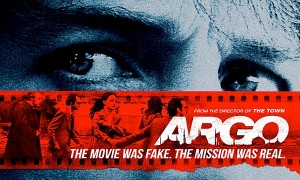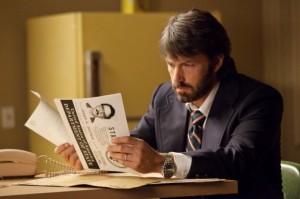Interview: Ben Affleck, Director and Star of “Argo” (Part 2)
Posted on October 15, 2012 at 3:33 pm
More from Ben Affleck about Argo:
What were some of the tougher scenes to film?
The scenes with the actors were the easiest scenes. We have all these good actors, they know what they’re doing, it was really fun. I got to enjoy acting with really good actors. Getting 2000 extras out in Turkey was really hard. It was cold and people wanted to go home and the idea was like, “Every hour, we’re going to give away sweet rolls!” But we’re still losing a lot of people who felt the sweet roll wasn’t worth hanging around and it was a lot of work. So that was tough. The car stuff wasn’t that bad. I was kind of excited, there was a car, sort of a Porsche Cayenne that has a huge crane on the back and it’s called “The Russian Arm” and they do incredible things with it. You can be driving like 100 miles an hour next to something else that’s 100 miles an hour and moving the crane around. They use them a lot for car commercials and I had wanted for “The Town” and we couldn’t afford it. This time I said, “We’re going to need the Russian arm” and we got it. I got play with it and that was a lot of fun.
 This was something of an homage to the late 70’s, you know, with the clothes and all the TV and Walter Cronkite. Was that something that attracted you to the movie?
This was something of an homage to the late 70’s, you know, with the clothes and all the TV and Walter Cronkite. Was that something that attracted you to the movie?
I’m the age of the kid in the movie and so I definitely identified with the child. When I went into his room, with all the action figures and the Star Wars stuff, it really hit me: this was my childhood. And I got really fastidious about the sheets and everything. There’s something remarkably innocent about that era. We think of the 70s as being slightly debauched in some ways, key parties and all those other sort of images we get from some other movies, but we had none of that technology, huge TVs, the people on television, you know, had these sort of crummy sets. Nowadays, we get a theme song and a graphic for every news story but then it was these gigantic cars that probably got 6 miles to the gallon, you know, it was the true sort of internal combustion engine in bloom and I don’t know—I thought there was something kind of sweet about it, sweet about the big answering machines and you just leave the house and that’s it. No one can find you until you come home. Put a quarter or a dime in a pay-phone slot…So I discovered a little bit more about it as I was doing it.
How are Hollywood and the CIA alike?
That is a good parallel, and it’s true, there is a symbiotic relationship. People make movies about military and if you go on a tour of the military, they’re all movie buffs, all these guys and women overseas. Movies are a big part of our culture, and both the movies and our military and our intelligence services (particularly our intelligence services) are inventing things, are filmmakers and actors for the sake of art and for entertainment and for our intelligence services, it’s for, God knows, skullduggery and spy-craft and all that kind of stuff. And they both tell stories. One of the themes of this movie is storytelling and how powerful it is, whether it’s political theatre or relating to our children or trying to get some people out of a place where their lives are in danger. Usually telling stories is incredibly powerful. There’s this shot I really like where there’s this firing squad and there’s a firearm, a rifle and a camera, and hopefully it’s subtle, but suggests that the camera is much more powerful than the gun. That has been really borne out, as in the YouTube era, as true.
You begin with strong criticism of the Shah and America’s support for him. Were you as tough on the people who took over after the revolution?
I don’t think anyone would argue that the Islamic Revolution was good for the country. It’s just that it was a reaction to the Shah who was not good for the country, who was embezzling a lot, and as you point out. Unemployment was low, but a lot of those jobs were done by foreigners, because they didn’t have Persians who were trained to fly the helicopters he was buying and run the cranes and even drive trucks, so there was a lot of importation of labor that the people resented. I didn’t have to show, in specific, what happened and how bad the revolutionaries became (so to speak) because you see them hanging people from construction cranes, you see firing squads happening impromptu in the streets, kangaroo courts, you see a place that’s living in fear under the revolutionary guard, so in that sense, you very much see what has happened to this country as the Islamic Revolution took hold. It’s an extraordinarily complicated scenario. Part of it was a reaction against the Shah, you know, the Savak were sort of modeled after the KGB, they were extremely oppressive, but there were a lot of people who really prospered under the Shah and the revolution was not fomented strictly as an Islamic revolution. There were merchants and communists and secularists and students and Islamists and nobody would have engaged in this revolution with most of those other people if they thought, “Well, we’re all just going to end under Khomeini.” In fact, Khomeini was able to use the hostage situation himself, which he didn’t engineer, but was supposed to be the short-term two-day thing that the students did. He sent his son to say, “You know what? Let’s keep the hostages here, let’s hold out and see what happens,” and because he sort of controlled this event, he was really able to marginalize the moderates in government. I was a Middle Eastern studies major, I took classes and classes and classes on this and still don’t feel I understood the Iranian revolution sufficiently. I do know that we tried to capture the essence of the truth; I absolutely standby the prologues, and people call it the history lesson, but I also acknowledge that we did not have the room, dramatically, to really get into the minutiae and the complexity and the nuance of what happened as the Islamic Revolution took hold. I do feel that we show it in a fairly negative light, but I also wanted to give people some context so that they see it just wasn’t just sort of mad barbarians who made a rush for a country, but that this was something that was developing over time as a reaction to the Shah’s policies.
Tell me about the character you play in the film.
I think Tony in real life was a guy who got his mission and got his orders and followed through, and it was rather uncomplicated. He had a certain amount of fear but he was going to do it. As a result, the story’s a little wonky, in a way, in the film, because it was really about the six people. If you want to talk about, like where your empathy is, where the line is that’s pulling you through the story, it’s the six people, not the guy on his horse with the sword who’s going to kill Saxons or whatever, you know. And then you start to be developed emotionally with these other characters who have different emotional relationships to the story, you know, John and Alan and Bryan and so on. I thought that was interesting, and I also sort of worked with Tony’s slightly passive personality, you know, that his focus was he was going to go and save these folks’ lives, and so they became a center of the wheel, the hub, in a way, and all of this other stuff was spokes in that way.








